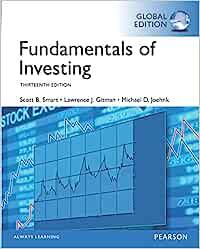Hal and Terri Wilson had most of their funds invested in common stock in late 2016. The
Question:
Hal and Terri Wilson had most of their funds invested in common stock in late 2016. The Wilsons didn’t really do very much investment planning, and they had practically no background or understanding of how income taxes might affect their investment decisions. Their holdings consisted exclusively of common stocks, selected primarily on the advice of their stockbroker, Sid Nichols. Despite a relatively lackluster market, they did experience some nice capital gains, even though several of their holdings showed losses from their original purchase prices. A summary of their holdings on December 20, 2016, follows.

Hal feels this might be a good time to revise their portfolio. He favors selling all their holdings and reinvesting the funds in several growth-oriented mutual funds and perhaps several real estate investment trusts (REITs). Terri agrees that their portfolio could use some revision, but she is reluctant to sell everything. For one thing, she is concerned that federal income taxes might take a sizable share of their profits. In addition, she strongly believes Amalgamated Iron & Steel will make a significant recovery, as will all steel stocks, in 2017.
After some discussion, the Wilsons decided to consult their friend, Elaine Byer, who was a CPA for a major public accounting firm. Byer indicated that she was not an expert in the investment field and therefore couldn’t tell the Wilsons which securities to buy or sell from that perspective.
From a tax point of view, however, she did not recommend selling everything in the 2016 tax year. Instead, she said that Consolidated Power and Light, PYT Corporation, Amalgamated Iron & Steel, and Jones Building Supplies should be sold in December 2016 but that Cargon Industries should be carried into 2017 and sold then—if that was what the Wilsons wanted to do.
Hal and Terri were grateful for Byer’s advice, but they had two major concerns. First, they were concerned about waiting to sell Cargon Industries because it had showed such a sizable gain and they were afraid its price might decline sharply in a stock market sell-off. Second, they were reluctant to sell Amalgamated Iron & Steel despite the benefit of its tax loss because they wanted to remain invested in the steel industry over the long run. As a final step, they contacted Nichols, their stockbroker, who agreed with Byer’s advice; he said not to worry about the Cargon situation. The stock was selling at $80 a share, and he would sell a deep-in-the-money call option on Cargon, which would enable them to deliver the shares sometime early in 2017. He also explained that they could use a tax swap to get the tax benefit of the loss on Amalgamated Iron & Steel while staying invested in the steel industry. He suggested United States Iron as a swap candidate because it was selling for about the same price as Amalgamated.
Questions
a. Assuming the Wilsons are in the 25% ordinary income tax bracket, calculate the resulting federal income tax
(1) if they sold all their securities in 2016 at their current market values,
(2) if they sold Consolidated Power and Light, PYT Corporation, Amalgamated Iron & Steel, and Jones Building Supplies at their respective market values in 2016 and then sold Cargon Industries for $8,000 on January 2, 2017 (i.e., assume that Cargon’s value doesn’t change in the next few weeks).
What do you conclude from your calculations?
b. As noted, Nichols suggested selling a deep-in-the-money call option on Cargon. Explain his reasoning about the future price of this stock.
c. Suppose you thought Cargon had a good possibility for further price increases in 2017, but you were equally concerned that its price could fall sharply. Would you then agree with the strategy Nichols recommended, or would you prefer a different strategy? Explain your answer.
d. Discuss the tax swap suggested by Nichols. Does this strategy allow the Wilsons to minimize taxes while retaining their position in the steel industry? Explain.
e. What overall strategies would you recommend to the Wilsons, given their investment objectives and tax status? Explain.
Step by Step Answer:

Fundamentals Of Investing
ISBN: 9781292153988
13th Global Edition
Authors: Scott B. Smart, Lawrence J. Gitman, Michael D. Joehnk





